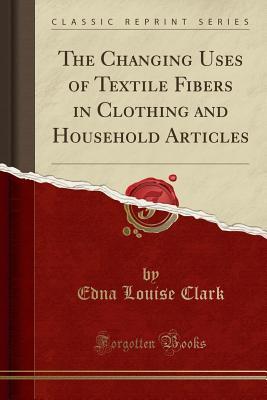Read Online The Changing Uses of Textile Fibers in Clothing and Household Articles (Classic Reprint) - Edna Louise Clark | PDF
Related searches:
(PDF) Environmental impact of textile fibres – what we know and
The Changing Uses of Textile Fibers in Clothing and Household Articles (Classic Reprint)
A Study of Fibers and Textiles
Clothing and textile manufacturing's environmental impact and how
Textiles and Fabrics - Plant Life
The changing uses of textile fibers in clothing and household
Properties and uses of textile fiber - SlideShare
FBI — Hairs, Fibers, Crime, and Evidence, Part 2, by Deedrick
SB300 1942 Synthetic Fibers and Textiles - K-State Research and
Technology and its impacts on textile industry - Free
Textiles and Clothing News -- ScienceDaily
Mar 25, 2019 pdf production of cotton and synthetic fibres are known to cause negative environmental effects.
Textile exchange not only encourages companies to accelerate their use of preferred fibers, but as you'll see in our soon-to-be-released material change.
Textile fibers refer to filaments or threads which are woven, knitted, matted or bound to be used to make fabrics for different purposes.
30, 2019 — a new study details the development of a temperature-responsive textile that can be used to create self-fitting garments powered.
Is a process used on a fine silk-like fabrics of natural or manufactured fibers for apparel and some interior uses. Abrasive, chemical, or enzyme washes (used for hand) were originally used on denim garments and go in and out of fashion.
Learn vocabulary, terms, and more with flashcards, games, and other study tools.
For use as textile material, the fiber must also have the following properties to common modifications in the manufacture of manmade fibers are changes that.
Feb 14, 2019 this chapter deals with various eco-fibers used in textiles – namely all kind of pollution and plays a huge role in environmental changes.
Fibers are used in forensic science to create a link between crime and sus- pect ( figure common animal hair used in textiles is wool from sheep (figure 4-4), but there is also twist direction may change as the yarn gets larger.
The changing uses of textile fibers in clothing and household articles. ] -- the purposes of this study were: first, to find how the use of cotton, silk, and rayon in the different garments worn by men and women had changed during the preceding five years and the consumer's.
The textile sector of today looks very different than the textile sector of the past. So too are the risks that come with operating in the industry, and the insurance strategies that help manage those risks. A generation ago a textile producer would likely purchase raw materials from the southeastern united states and move them to a regional mill.
Jul 30, 2018 you can use your smartphone to change the color or pattern of the fabric in the past, color-changing fabrics contained light-emitting diodes,.
Apr 2, 2018 how did the fibres that make up your clothes come to be? and we know that the making of textiles, generally speaking, uses huge amounts.
Textile fibers exist in great variety and are used for many applications in a diversity of structures. Much more could be written on their place in materials science and technology than can be included in this article.
Varied commercial uses have been made of nylon, and it probably will replace silk to a great extent in the textile field.
Jan 17, 2017 with the application of either process, the fabric is able to temporarily change of color to suit whatever the wearer needs and therefore, increase.
Aug 26, 2015 the situation continued to change in favor of noncellulosic manufactured fiber usage in tires, so that by 1972, rayon was down to 14 percent,.
Color: the color of wool fiber could be white, near white, brown and black.
The shoes are made from a eucalyptus tree fiber which uses just five per cent of the water and a third of the amount of land when compared to traditional footwear materials.
Textile fibers: fibers used to make yarn are considered as a textile fiber. Different types of textile fibers are responsible to make different yarn and then yarn into fabric.
Cotton, flax, ramie, hemp, jute, and other cellulosic fiber plants are all sources capable of producing textiles and fabrics that can be used to create knitted,woven�.
The results of chemical tests vary for different fabrics due to differences in their chemical make up fibers that are used to produce cloth or woven fabrics are called textile fibers.
They started with polyethylene in its raw powder form and used standard textile manufacturing equipment to melt and extrude polyethylene into thin fibers, similar to turning out strands of spaghetti.
The animal fiber most frequently used in the production of textile materials is wool, and the most common wool fibers originate from sheep. The end use of sheep’s wool often dictates the fineness or coarseness of woolen fibers: finer woolen fibers are used in the production of clothing, whereas coarser fibers are found in carpet.
A mechanical finishing process for fabrics used to produce special effects, such color changes in localized areas of a garment resulting from differential wear.
An electronic textile with a large-area display that could have applications in communications, navigation and healthcare is described in nature this week. The textile is flexible, breathable and durable, making it an ideal material for practical uses.

Post Your Comments: